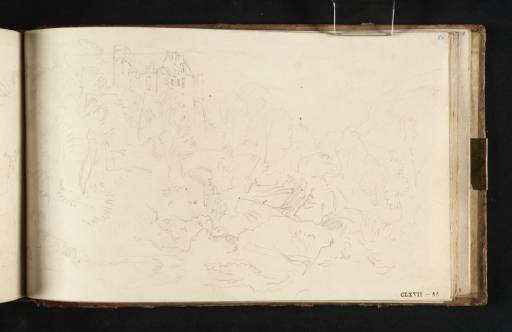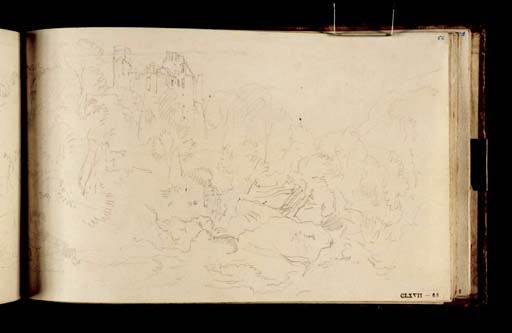Joseph Mallord William Turner Roslin Castle 1818
Image 1 of 2
Joseph Mallord William Turner,
Roslin Castle
1818
Joseph Mallord William Turner 1775–1851
Folio 69 Recto:
Roslin Castle 1818
D13704
Turner Bequest CLXVII 66
Turner Bequest CLXVII 66
Pencil on white wove paper, 112 x 186 mm
Inscribed in pencil by Turner ‘[?F/T/J...]’ left; ‘3 | 2 | 26 | 6 | 13 | 77’ centre
Inscribed in blue ink ‘66’ top right
Stamped in black ‘CLXVII 66’ bottom right
Inscribed in pencil by Turner ‘[?F/T/J...]’ left; ‘3 | 2 | 26 | 6 | 13 | 77’ centre
Inscribed in blue ink ‘66’ top right
Stamped in black ‘CLXVII 66’ bottom right
Accepted by the nation as part of the Turner Bequest 1856
References
1909
A.J. Finberg, A Complete Inventory of the Drawings of the Turner Bequest, London 1909, vol.I, p.487, CLXVII 66, as ‘Roslin Castle.’.
1974
Martin Butlin, Andrew Wilton and John Gage, Turner 1775–1851, exhibition catalogue, Royal Academy, London 1974, p.85 under cat.206.
1980
Gerald Finley, Landscapes of Memory: Turner as Illustrator to Scott, London 1980, p.52 plate 10.
1982
Francina Irwin, Andrew Wilton, Gerald Finley and others, Turner in Scotland, exhibition catalogue, Aberdeen Art Gallery and Museum 1982, p.45.
1997
Martin F. Krause, Turner in Indianapolis: The Pantzer Collection of Drawings and Watercolors by J.M.W. Turner and his Contemporaries at the Indianapolis Museum of Art, Indianapolis 1997, p.138.
1999
Katrina Thomson, Turner and Sir Walter Scott: The Provincial Antiquities and Picturesque Scenery of Scotland, exhibition catalogue, National Gallery of Scotland, Edinburgh 1999, p.91 fig.24.
2000
Eric Shanes, Evelyn Joll, Ian Warrell and others, Turner: The Great Watercolours, exhibition catalogue, Royal Academy of Arts, London 2000, p.113.
Although Finberg did not acknowledge it,1 this page has subsequently become recognised as the basis of Turner’s watercolour of Roslin Castle, circa 1820 (Indianapolis Museum of Art).2 Like several of the castles included in Scott’s Provincial Antiquities (Dunbar, Tantallon and Linlithgow Palace to some extent, as well as the proposed but unpublished Blackness Castle), Roslin was located at a spot that would offer the protection of water on three sides. Thus the castle was built on a promontory into the North Esk River, with steep rocky banks on three sides. The castle was further defended by breaching the fourth side with a ditch, originally bridged by a drawbridge. The castle was first built in the early fourteenth century, though suffering several fires and attacks it had to be rebuilt at various times. Roslin held a special significance for Scott who had lived in a cottage on the Esk below the castle, and had written about it in his poem the Gray Brother.3 Turner first visited the site in 1801, and returned in 1818 to gather sketches for an illustration for the Provincial Antiquities.
In this sketch the castle is seen from the bottom of Roslin Glen to the south. The River Esk splashes around large boulders in the foreground, fed by a waterfall that is shown, though not obviously, in this sketch on the right. The castle is at the top of a heavily wooded and rocky bank, partially hidden by trees which are identified as ‘ash’ on folio 68 verso (D13703; CLXVII 65a). At the left of the castle are the ruins of the keep, and the main visible structure is the late sixteenth century East Range (a more detailed sketch of which was made in the Edinburgh, 1818 sketchbook, Tate D13576; Turner Bequest CLXVI 65a). To the left of the castle, at the very edge of the page Rosslyn (as it tends to be spelled) Chapel can just be seen from between the trees.
The viewpoint is identical to the watercolour, although that work places the castle towards the centre of the picture, giving it and the chapel more space in the composition. The castle appears larger in the watercolour as it is less foreshortened by perspective, and its masses are simplified by the use of a limited range of tones. The waterfall is revealed in the watercolour, while it is screened by trees in the sketch, and some of the boulders are moved around, with more added in the left foreground. Some of these changes are hinted at in a rough sketch in the Edinburgh, 1818 sketchbook (Tate D13500l; Tuner Bequest CLXVI 26a) which has informed the overall compositional layout of the watercolour. Comparable viewpoints also exist in the Edinburgh, 1818 sketchbook (Tate D13524 and D13525; Turner Bequest CLXVI 38a and 39). There is a similar view of the castle on the previous sketchbook page (folio 68 verso), although that sketch was made from closer to, and pays more attention to the rocks and trees than to the castle.
Thomas Ardill
March 2008
How to cite
Thomas Ardill, ‘Roslin Castle 1818 by Joseph Mallord William Turner’, catalogue entry, March 2008, in David Blayney Brown (ed.), J.M.W. Turner: Sketchbooks, Drawings and Watercolours, Tate Research Publication, December 2012, https://www


